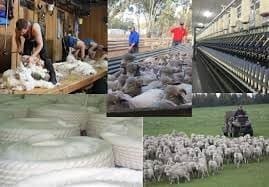The Australian wool industry may witness a crippling effect of restrictions on its wool exports to China along with the lack of viable alternative markets, according to a report released last week by the country’s Rural Bank that outlines China’s share of Australian agricultural exports and the potential effect if any trade sanctions were put in place.
China is Australia’s largest market for wool exports and has been since the early 1990s, with two-thirds of all Australian wool production exported to China. China accounted for 77.4 per cent of the value of Australian wool exports in 2019-20, totalling $1.9 billion.
This makes wool an agricultural commodity in Australia that is the most heavily reliant on China.
At the recent Australian Wool Innovation’s (AWI) annual general meeting, chief executive officer Stuart McCullough told the meeting the maximum demand for Australian wool came from China place this year. But AWI has had an emerging market strategy in place for the past eight years with decent success, he said.
That has witnessed an increase in processing and consumption of wool in countries like India, Vietnam, Bangladesh and Sri Lanka, McCullough was quoted as saying by Australian media reports.
“Emerging markets remain a key strategy of the company and something we will push forward with in the years to come,” he said. Given the significant proportion of Australian wool that is exported to China and China’s dominance as a woollen textile manufacturer, it is no surprise that there are few viable alternatives for Australian wool exports.
Italy, Australia’s second largest market for wool, only accounted for 5.8 per cent of export value in fiscal 2019-20. India and the Czech Republic are also small markets for Australian wool, accounting for 5.4 per cent and 2.9 per cent of export value in 2019-20 respectively.
According the Rural Bank’s report, given the scale of woollen textile manufacturing in these countries, there would be a very low possibility of being able to purchase the volume of Australian wool that currently is shipped to China.
However, the report stated the outlook for wool prices are already unfavourable as the impacts of COVID-19 already reduced demand for high-value woollen clothing.
Reduced demand is set to be met by increased supply on the back of improved seasonal conditions and carry-over stocks from last season. This has already seen wool prices drop to the lowest level in over five years in recent months.
Wool prices are, however, stabilizing in the last couple of weeks, McCullough said.
Given China’s mutual reliance on the trade of Australian wool it would be unlikely that China would impose significant trade access restrictions on Australian wool.
But any reduction in access would likely lead to a further decline in prices given the current subdued demand and increased supply environment.

